The regional distribution of anxiety disorders: implications for the Global Burden of Disease Study, 2010
- PMID: 25048296
- PMCID: PMC6878273
- DOI: 10.1002/mpr.1444
The regional distribution of anxiety disorders: implications for the Global Burden of Disease Study, 2010
Abstract
Anxiety disorders are increasingly acknowledged as a global health issue however an accurate picture of prevalence across populations is lacking. Empirical data are incomplete and inconsistent so alternate means of estimating prevalence are required to inform estimates for the new Global Burden of Disease Study 2010. We used a Bayesian meta-regression approach which included empirical epidemiological data, expert prior information, study covariates and population characteristics. Reported are global and regional point prevalence for anxiety disorders in 2010. Point prevalence of anxiety disorders differed by up to three-fold across world regions, ranging between 2.1% (1.8-2.5%) in East Asia and 6.1% (5.1-7.4%) in North Africa/Middle East. Anxiety was more common in Latin America; high income regions; and regions with a history of recent conflict. There was considerable uncertainty around estimates, particularly for regions where no data were available. Future research is required to examine whether variations in regional distributions of anxiety disorders are substantive differences or an artefact of cultural or methodological differences. This is a particular imperative where anxiety is consistently reported to be less common, and where it appears to be elevated, but uncertainty prevents the reporting of conclusive estimates.
Keywords: anxiety; epidemiology; meta-analysis; modelling; public mental health.
Copyright © 2014 John Wiley & Sons, Ltd.
Figures





References
-
- Aalto‐Setala T., Marttunen M., Tuulio‐Henriksson A., Poikolainen K., Lonnqvist J. (2001) One‐month prevalence of depression and other DSM‐IV disorders among young adults. Psychological Medicine, 31(5), 791–801. - PubMed
-
- Abas M.A., Broadhead J.C. (1997) Depression and anxiety among women in an urban setting in Zimbabwe. Psychological Medicine, 27(1), 59–71. - PubMed
-
- Adewuya A.O., Ola B.A., Adewumi T.A. (2007) The 12‐month prevalence of DSM‐IV anxiety disorders among Nigerian secondary school adolescents aged 13–18 years. Journal of Adolescents, 30(6), 1071–1076. - PubMed
-
- Almqvist F., Puura K., Kumpulainen K., et al (1999) Psychiatric disorders in 8–9‐year‐old children based on a diagnostic interview with the parents. European Child and Adolescent Psychiatry, 8(4), 17–28. - PubMed
-
- Anderson J.C., Williams S., McGee R., Silva P.A. (1987) DSM‐III disorders in preadolescent children. Prevalence in a large sample from the general population. Archives of General Psychiatry, 44(1), 69–76. - PubMed
MeSH terms
LinkOut - more resources
Full Text Sources
Other Literature Sources
Medical

